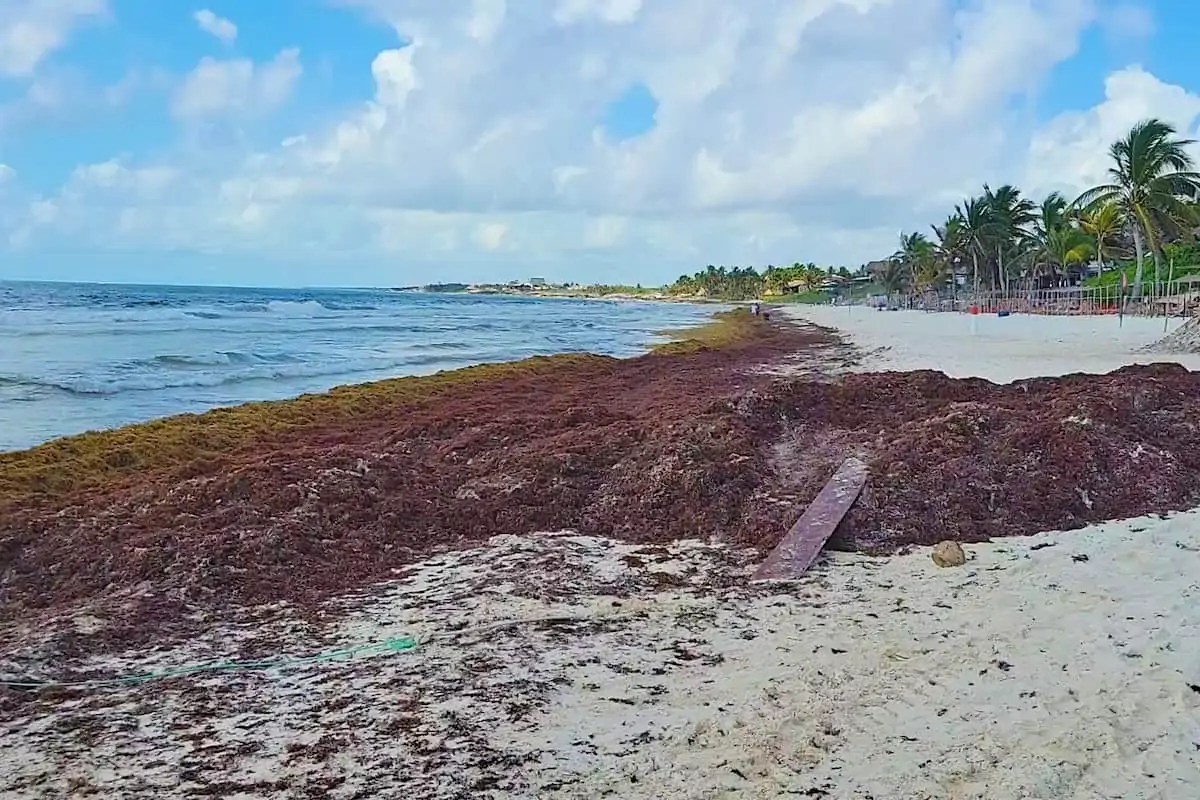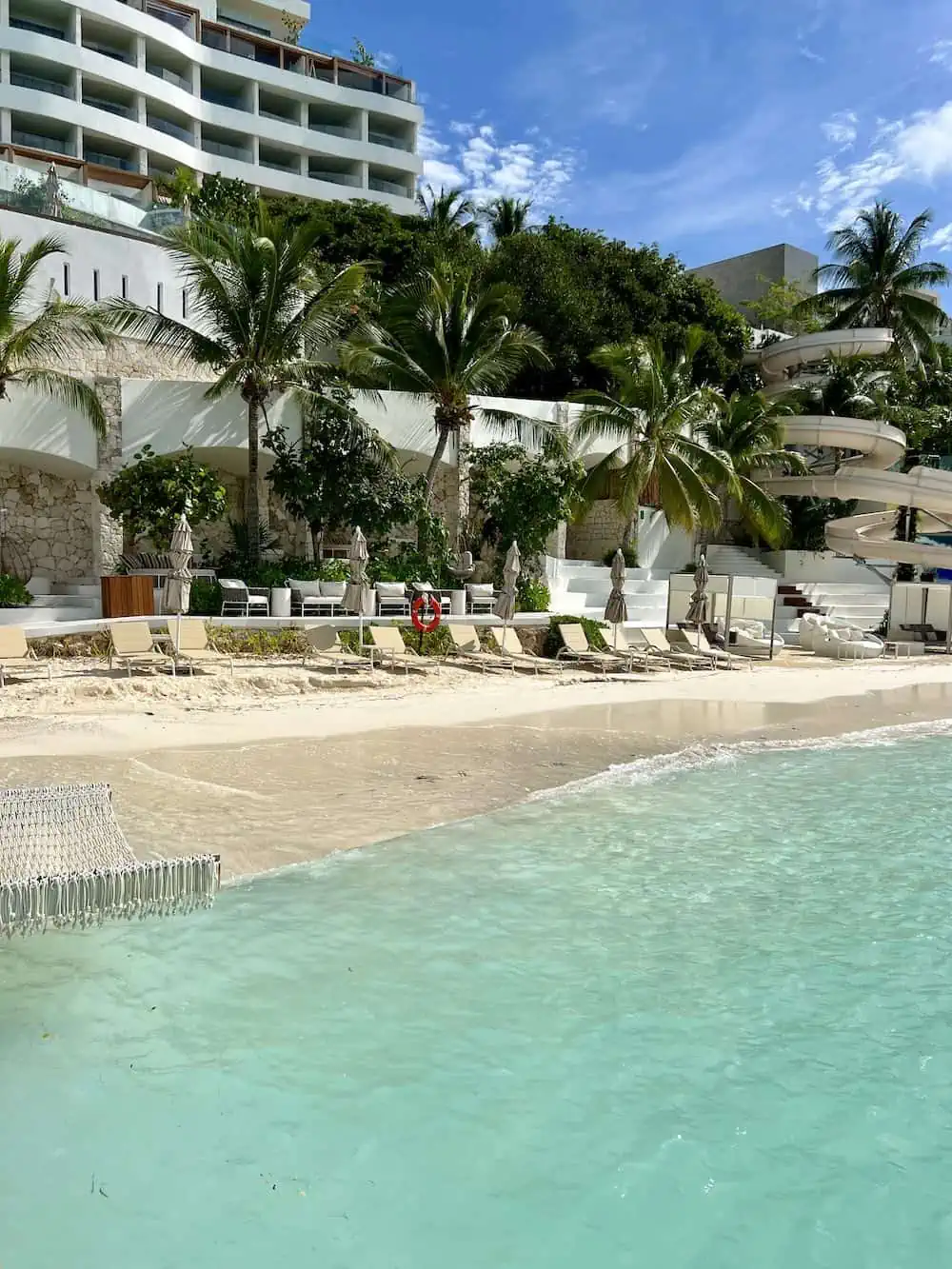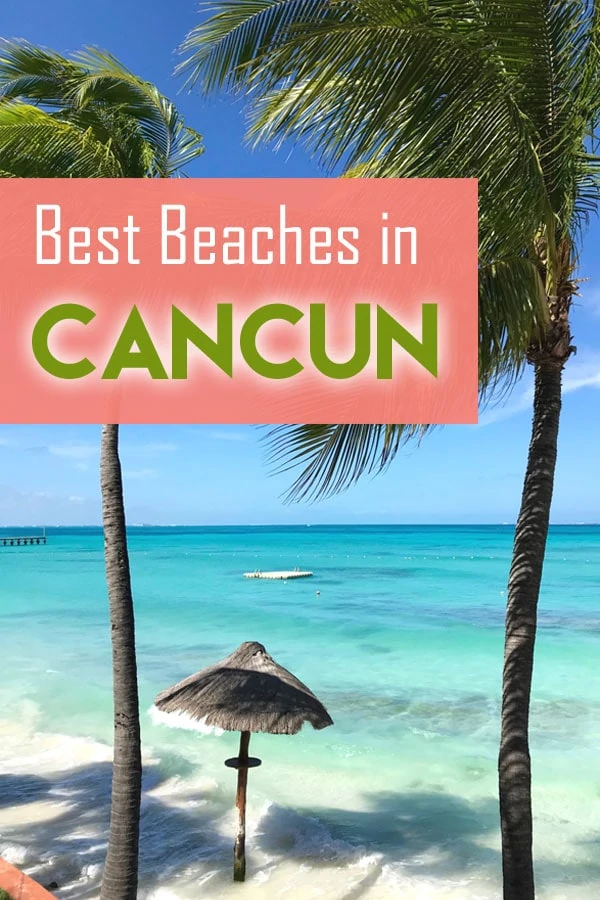We may earn income from links in this post. Please read this Disclosure for details.
If you’re planning a beach vacation and are worried about the current seaweed conditions in Cancun and Riviera-Maya, this post has important information about seaweed season.
It also has the latest updates on the Cancun seaweed problem and details on sargassum seaweed in 2024 and the seaweed forecast for 2024.
Over the past 10 years, I’ve personally walked the beaches of Mexico’s Caribbean coast during seaweed season many times.
This report is from my trip to Cancun Riviera Maya in June 2024. The good news is that there is LESS seaweed than was forecast!!
While the quantity of seaweed coming to shore varies every year, certain beaches have more sargassum seaweed than others.
Here are my expert tips on planning the best beach vacation to Cancun and Riviera Maya in 2024!

It includes suggestions on how to find the best beaches for swimming, even during the height of seaweed season in Cancun.
Note: This is a recurring post updated with original photos, sargassum seaweed maps and information on seaweed conditions and the status of the current seaweed problem in Cancun, Playa del Carmen, Cozumel, Puerto Morelos, Isla Mujeres and Tulum.
Contents of This Guide to Cancun Sargassum

Cancun Seaweed Season Right Now – A Quick Snapshot
June 2024: The forecast is by July 2024 onward, Cancun and the Mexican Caribbean coast will see a decrease in sargassum.
February 2024: The outlook for 2024 by University of South Florida suggested that there could be a major bloom of sargassum in 2024.
The university’s tracking system identified a large mat of sargassum seaweed in the Central Atlantic in February 2024.
The abundance was similar to conditions observed in 2017 and 2020, both of which preceded major seaweed blooms.
However seaweed on Cancun, Tulum, Playa del Carmen beaches in 2024 has been lower than predicted.

However, much depends on ocean and wind currents.
Read on to see original photos and learn which areas could be at risk.

Sargassum Seaweed Facts

What exactly is sargassum seaweed and why is it a problem?
Sargassum (also known as sargazo and sargasso) is a type of brown algae that generally lies in the open ocean in the Sargasso Sea in the North Atlantic.
Wrapped by ocean currents, this mat of seaweed floats on the surface of the water. It serves as a resting area and spawning ground for a vast array of life from eels to sea turtles.
While sargassum seaweed is a natural phenomenon that has been occurring for centuries, the influx of sargassum in recent years have been larger, thicker and more widespread.
Since 2011, blooms of sargassum have been appearing in the tropics sweeping up from South America through the Caribbean along the coast of Mexico and into the Gulf of Mexico and Florida.
The summer of 2018 witnessed the worst influx of sargassum brown algae in recent history. In 2022, the seaweed problem was equally as bad.

The quantity of the sargassum seaweed combined with differences in the composition of the seaweed itself, poses problems.
Large quantities of seaweed float on the surface of the water, wash up on beaches, trap marine life in the seaweed itself and use up the oxygen that fish need to breathe.
Various strategies — from raking it manually to using barriers to catch the sargassum before it reaches the shore — have been devised to try to deal with the unprecedented waves of seaweed that have engulfed regions of the Caribbean and Mexico in 2015, 2018, 2019, 2020, 2021 and 2022.
Is it Dangerous to Swim in Sargassum Seaweed?
Sargassum seaweed in itself doesn’t pose a problem, says Dr. Jeffrey Rapaport at Holy Name Hospital in Teaneck (Emeritus head of Dermatology). Instead, it’s what the seaweed harbours that can cause skin irritations and other risks.
The seaweed when floating at the top of hot, shallow waters, can start to play host to microbes and strains of bacteria the skin is not accustomed to coming in contact with. Also, you have to remember that fish normally use sargassum as a breeding grounds — leaving toxins and eggs in seaweed.
With freshwater as well as saltwater swimmers should watch out for the growth of Cyanobacteria (which can normally be seen changing the water’s colour to light green).
Cyanobacteria can release neurotoxins, which not only can affect the skin but can cause the death of neurons that control most of the muscles and movements in your body.

Another risk occurs when sargassum seaweed gathers in large quantities, washes up on beaches and begins to decompose. It releases hydrogen sulfide gas, or H2S, a colourless, poisonous gas with an unpleasant rotten-egg odor,
According to Eric Najarro, Administrator at the Dr. Otto Rodriguez San Pedro Polyclinic II in Belize, inhaling small doses of the gas can trigger irritation of the eyes, respiratory issues and nausea, especially among at-risk people such as those with asthma, the elderly, infants and pregnant women.
Certain animals, especially dogs, are also sensitive to the inhalation of hydrogen sulfide.
Another health risk to swimming with large quantities of sargassum seaweed is the potential for skin irritations and rashes.
So if you’re wondering if it’s safe to swim in sargassum seaweed, according to the experts I’ve consulted, it’s not advisable.
Note that red tide and sargassum seaweed are two different problems. A red tide is a bloom of algae that discolours coastal waters and releases dangerous toxins.
Eating shellfish or other seafood during an algal bloom is harmful to humans.
When is Seaweed Season in the Caribbean and Mexico?

In the Caribbean, seaweed season is generally May to October. The worst time for seaweed in Cancun, the Dominican Republic, Trinidad & Tobago and much of the Caribbean is during the summer months.
Looking for vacation ideas on Caribbean islands not affected by sargassum seaweed? Check out our Guide to Caribbean Beaches without Sargassum Seaweed.
The seaweed season in Cancun is generally over by the end of October. However, some towns such as Puerto Morelos sometimes continue to receive sargassum seaweed past that date.

However, the state of Quintana Roo has been working on strategies to cope with the seaweed problem.
In addition to aerial surveillance, they have issued contracts to hire companies to collect and dispose of the seaweed.
Seaweed Conditions in Cancun

The quantities of seaweed in Cancun and along the Caribbean coast will vary depending upon ocean currents, the size of the sargasso seaweed mat, seasonality, ocean currents and wind conditions.
If you want to avoid the worst time for seaweed in Cancun and reduce the likelihood of it ruining your vacation, it’s worth considering which beaches to choose for your vacation.
For example there can be large quantities of algae in Petempich Bay, in Puerto Morelos, Recodo Beach, in the municipality of Solidaridad (Playa del Carmen), as well as Punta Mosquitos on Holbox Island.
Yet the rest of the coast can be relatively clear.
Where in Cancun is There No Seaweed?

The best bet for beaches near Cancun with no seaweed is to head to the island of Isla Mujeres or to the leeward coast of Cozumel by ferry.
Beautiful Playa Norte (north beach) on Isla Mujeres is almost always clear of seaweed. Many of the hotels on the southwest coast of the island are also seaweed free.
We just returned from the newly-opened Impression Isla Mujeres by Secrets and loved its small private beach.

For more information on this all-inclusive, adults-only luxury resort, read our full review of Impression Isla Mujeres.
Another option is Playa Mujeres on the mainland north of Cancun.
Also on the mainland, Coral Beach stretches along the northern shores of what’s known as Punta Cancun or the most northerly point of the Cancun Hotel Zone.
This public beach occasionally gets hit by seaweed but usually it’s nothing major.
Next door at the Grand Fiesta Americana Coral Beach Cancun Resort & Spa, the private beach is often completely clear of sargassum. It features powder soft white sands and clear turquoise waters.
It is usually protected from seaweed by nearby Isla Mujeres. However wind and ocean currents can change and seaweed conditions at Grand Fiesta Americana Coral Beach Cancun can change quickly.
SCROLL DOWN TO SEE THE LATEST MAP OF SEAWEED CONDITIONS in Cancun
An advantage of Coral Beach is that the waters are calm and the entry is gradual with no steep drop-off. This makes it ideal for those who aren’t expert swimmers.
In my opinion, this is the best beach in Cancun for swimming. Beginner swimmers, small children and seniors will all enjoy swimming at this beautiful beach.
Best Cancun Beaches Without Seaweed – Playa Gaviotas and Playa Gaviotas Azul

One of the most popular public beaches in Cancun, Playa Gaviotas Azul is located at the northern tip of the hotel zone.
Beach access is between Coco Bongo and the Mandala Beach Club opposite Hooters via a narrow alleyway. Current seaweed conditions at Playa Gaviota Azul depend on the intensity of the ocean currents.
Most small clumps of seaweed on the sand are raked up by hotel staff. There is often very little sargassum seaweed floating offshore. But this is not always the case.
However wind and ocean currents can change and seaweed conditions can change quickly.
The major hotels on these beaches include the all-inclusive Krystal Cancun and the Hyatt Ziva Cancun at the point of the peninsula.
SCROLL DOWN TO SEE THE LATEST MAP OF SEAWEED CONDITIONS in CANCUN .
Best Cancun Beaches Without Seaweed – Playa Delfines / Dolphins Beach

This long, wide public beach at the southern end of the Hotel Zone is known as Playa Defines. It’s one of the most popular beaches in Cancun.
You’ll also see line-ups of people waiting to get a photo-op in front of the CANCUN sign.
The amount of seaweed on Playa Delfines varies considerably from week to week. See below for a photo of what it looked like in 2018.

However wind and ocean currents can change and seaweed conditions can change quickly.
If there is a lot of seaweed at Playa Delfines, a good option is to take a ferry to Isla Mujeres or Isa Cozumel. The leeward beaches on those islands almost always have no sargassum seaweed.
Check our list of the best all-inclusive resorts in Cancun Riviera-Maya.
Current Cancun Seaweed Conditions – Sargassum Forecasts for 2024

Seaweed forecasts by the experts have historically been quite accurate.
A report by Brigitta Ine van Tussenbroek, an ocean researcher from the Institute of Marine Sciences and Limnology at the National Autonomous University (UNAM) suggested large quantities of sargassum seaweed would return to Mexico’s Caribbean coast. Her report was quite accurate.
For seaweed season in 2024, the Sargassum Early Advisory System (SEAS) forecasting project showed several large floating masses of seaweed in the Atlantic between southern Africa and Brazil.
Whether it lands in Cancun, Chetumal, Tulum or the Riviera Maya depended much upon atmospheric conditions such as trade winds.
According to the University of South Florida’s Outlook of Sargassum blooms in the Caribbean Sea and Gulf of Mexico, based on offshore conditions, the seaweed forecast for 2024 suggested it would be another major Sargassum year.
The forecast is by July 2024, Cancun and the Mexican Caribbean coast will begin to see a decrease in Sargassum.
So it’s wise to keep a watch on seaweed conditions as landings of sargassum can change from day to day.

Current Seaweed Conditions in Tulum

How is the government dealing with the seaweed problem in Tulum, Playa del Carmen and Mexico’s Caribbean Coast?
When needed, the government of Quintana Roo issues an emergency declaration for the municipalities of Lázaro Cárdenas, Isla Mujeres, Benito Juárez, Puerto Morelos, Cozumel, Solidaridad, Tulum, Felipe Carrillo Puerto, Bacalar and Othón P. Blanco.
Declaring a State of Emergency enables local authorities to access funding to combat the volume of seaweed by removing accumulations and blocking it by various methods.
For seaweed season in 2024, analysis by the University of South Florida’s Outlook of Sargassum blooms in the Caribbean Sea and Gulf of Mexico suggested there could be a large amount of sargassum in 2024. But the reality is it’s been lower.
Tulum and Chetumal have often been hit the worst. But it’s important to note that from Tulum to Cancun seaweed conditions can change daily depending on tides and water temperature.

If sargassum conditions are bad on Tulum’s beaches, it’s worth trying the beach club at Caleta Tankah. The ocean here often has clear waters.
Playa del Carmen Seaweed in 2024
The popular resort town of Playa del Carmen has been experiencing a double whammy of challenges in recent years.
The main problems are the erosion of its beaches and the influx of sargassum seaweed along the coast. Seaweed in Playa del Carmen has a tendency to get trapped and decompose.
This makes it smell and release dangerous gases such as hydrogen sulfide gas, or H2S, a colourless, poisonous gas with an unpleasant rotten-egg odor,.

The seaweed season usually ends in October in Playa del Carmen.
But if you’re visiting Playa del Carmen in seaweed season, it’s possible to avoid seaweed problems in Playa del Carmen by staying at resorts that have created inland beaches.

Both the Xcaret Hotel Arte (adults-only) and Xcaret Hotel (family-friendly) have created several inland beaches so guests can avoid major sargassum mats.
Another all-inclusive resort in Playa del Carmen, Impression Moxché by Secrets, also created an artificial inland beach where you can enjoy soft sand and clear water in seaweed season.
Further south, a fantastic all-inclusive resort without seaweed is the Hard Rock Hotel Riviera Maya in Puerto Aventuras. It’s one of the best places to stay in seaweed season in Cancun and Riviera Maya.
Here, the inland beach has no seaweed because it’s protected by a rocky breakwater. But the tidal pools allow fresh seawater to enter. The water is clear enough to snorkel among tropical fish and has an added bonus of being quite calm.

Any sargassum seaweed that manages to sneak into the beach zone is promptly removed by staff. So there’s no seaweed to accumulate and rot.

Sargassum Forecast for Seaweed Season in Mexico in 2024
In Mexico, sargassum seaweed season is generally between May and October each year.
If you travel to the Caribbean coast of Mexico outside of that time period you can generally avoid large mats of seaweed on the beaches.
June 2024:

Get the latest seaweed maps on the Red de Monitoreo del Sargazo Cancun Facebook Page .
July 2021:

March 2022

If you are planning a vacation during seaweed season (May to October), monitor current seaweed conditions throughout the Caribbean, Mexico and the Gulf of Mexico by consulting the following resources.
Sargassum Seaweed 2024 Forecast Resources
The resources will also help plan a beach vacation by providing forecasts on seaweed in 2024.
- Check the forecast at the University of South Florida’s Outlook of Sargassum blooms in the Caribbean Sea and Gulf of Mexico.
- Consult the Sargassum Early Advisory System (SEAS), a forecasting project based in Texas intended to help predict the movement of sargassum blooms. Originally created in 2013 to help with forecasting of the large Sargassum landings in Texas, by 2017 the SEAS project had expanded to provide forecasting for the Gulf Coast, Mexico, Grand Cayman, Jamaica, Haiti, Saba, the Dominican Republic, Puerto Rico and many other Caribbean islands. The SARGASSUM EARLY ADVISORY SYSTEM can forecast sargassum seaweed masses up to eight days in advance.
- Get seaweed maps, updates and a Seaweed Report from the Red de Monitoreo del Sargazo Cancun Facebook Page . This not-for-profit group is made up of engineers, biologists and other experts who are volunteering their time to provide monitoring expertise and services. They publish a map of areas affected by sargasso seaweed in Cancun, Riviera Maya, Cozumel and Tulum.
- Check Riviera Maya and Cancun Beach Webcams at Live Webcam to see live video frames updated every 15 seconds.
- Subscribe to get drone views and updates on sargazo seaweed in Playa del Carmen on the Doctry 360 YouTube channel.
- Consult our article on Caribbean Beaches Without Seaweed for vacation options in Mexico and several Caribbean islands.
- Subscribe to the free A Taste for Travel newsletter for updates on the best beaches, seaweed conditions and other travel tips!
- Consider resorts at beach destinations on Mexico’s Pacific Coast where there is no sargassum. Popular beach destinations include Huatulco, Puerto Escondido and Puerto Vallarta.
FAQs
Seaweed season in Cancun is May to October so if you are visiting during those months in 2024 you could encounter sargassum seaweed on the beaches and/or in the water. Based on the quantity of sargassum seaweed currently in the Atlantic, there could be a major seaweed problem in 2024 in the Caribbean Sea (affecting Cancun, Tulum and Playa del Carmen) depending on wind and ocean currents.
The amount of sargassum seaweed in Cancun varies by season and even daily. Generally the worst months for seaweed are July and August.
Tulum, Mexico has a history of receiving influxes of sargassum seaweed during seaweed season. Seaweed season is generally between May and October. Based on the large size of the sargassum mat currently in the Atlantic, experts forecast that Tulum could have a major seaweed problem in 2024, depending on ocean and wind currents.
More Posts About Cancun and Caribbean Beaches
Save to Pinterest!







Dividing her time between Canada, Guatemala and Mexico (or the nearest tropical beach), Michele Peterson is the founder of A Taste for Travel. Her award-winning travel and food writing has appeared in Lonely Planet’s cookbook Mexico: From the Source, National Geographic Traveler, Fodor’s and 100+ other publications.
Read more about Michele Peterson.


